In today’s post, we’re addressing questions related to RV propane tanks.
With cooler temperatures heralding the coming of winter the season after fall, we’ve been focusing on various related topics, while at the same time trying to avoid being too blunt about the upcoming colder weather.
Today we’re addressing some additional common questions about propane, propane tanks, and propane safety in general.
Let’s do this before too much white stuff falls from the sky.
- 1) Important Propane-Related Topics
- 2) Is There a Difference Between a BBQ Propane Tank and an RV Propane Tank?
- 3) What Size Propane Tank Do I Need for an RV?
- 4) How Long Does 20 Gallons of Propane Last in an RV?
- 5) Can You Leave the Propane Tank On in an RV?
- 6) Can I Use a 100-Pound Propane Tank On My RV?
- 7) Why Are Propane Tanks Only Filled to 80%?
- 8) Important Final Note Regarding RV Propane Safety
You may have noticed our series of recent propane-related posts. If you missed them, you may be interested in visiting them ahead of… well, you know.
- Does Propane Go Bad In an RV?
- How Long Does a Propane Tank Last When RVing?
- Can You Use a Propane Heater Indoors to Heat Your RV?
- How Long Are Propane Tanks Good For on an RV?
You may also want to go back and take a look at these two posts:
- How Much Propane Does an RV Furnace Use?
- RV Furnace Not Working? Let’s Troubleshoot!
With these specific propane-related posts laid out for your convenience, let’s get to the general questions that inspired today’s post.
Is There a Difference Between a BBQ Propane Tank and an RV Propane Tank?
Yes and no.
Some RVs use the same exact type of propane tank that a traditional barbeque grill uses, but some use a different type of tank.
You’ll recall from previous posts that there are a couple of different types of propane tanks used on RVs. One is a DOT propane cylinder (commonly associated with the BBQ grill) and the other is an ASME tank.
DOT Propane Cylinder
Some RVs, (especially smaller campers, travel trailers, truck campers, and 5th wheels), carry either one or two DOT propane cylinders.
This is the type of portable tank that you frequently see connected to a home BBQ grill.
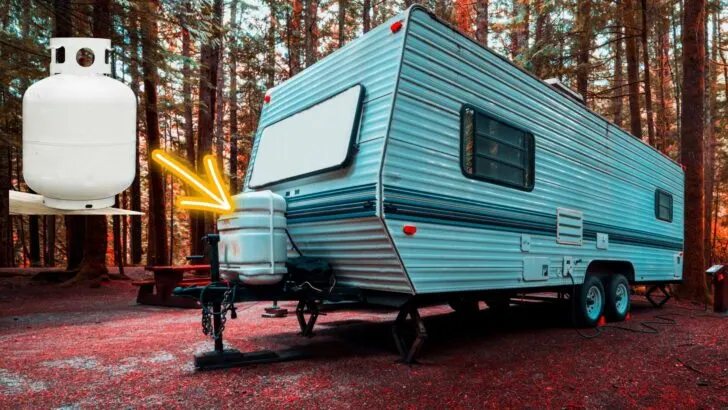
DOT propane cylinders are carried on certain types of RVs like this travel trailer. Generally, you’ll see one or two cylinders under a tank cover as shown here.
DOT tanks are designed and governed by the standards of the Department of Transportation.
They’re made for portable applications and need to be replaced or recertified every 12 years (10 years in Canada).
ASME Tank
ASME tanks are made of somewhat thicker, heavier steel and are designed for more permanent applications. They may be permanently installed on an RV or outside a home or business.
The design and standards of ASME tanks are governed by the American Society of Mechanical Engineers, and while they don’t require periodic recertification, they should be inspected for rust, damage, and leaks on a regular basis.
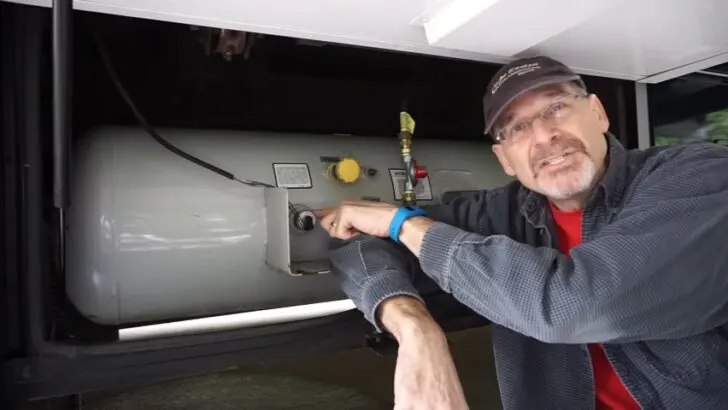
Some RVs (like ours) have ASME propane tanks permanently built into the structure of the rig.
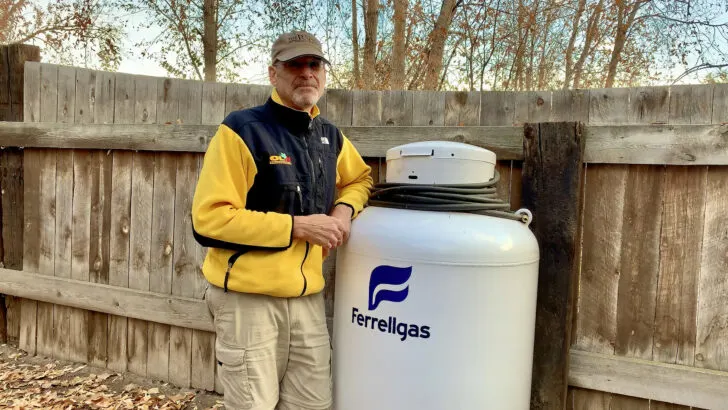
This type of ASME propane tank is semi-permanently installed by a propane supplier at a stationary location such as a home or business (in this case, an RV park). Some RVers who are stationary for long periods may have access to ASME propane tanks like these which are both very large, and refilled as needed by a local propane retailer.
What Size Propane Tank Do I Need for an RV?
This really depends on how many propane appliances your RV has and how many units of heat each uses. It also depends on how you RV (snowbirding anyone?).
A BTU (British Thermal Unit) is a measurement of units of heat. By definition, a BTU is the amount of heat required to raise the temperature of one pound of water by one degree Fahrenheit.
The approximate energy provided by one gallon of propane is 90,000-100,000 BTUs.
So, if you have a 30,000 BTU furnace, it will burn about ⅓ of a gallon of propane running continuously for one hour, which equals about a gallon of propane every three hours.
A larger furnace will burn more, and a smaller furnace will burn less.
But you also need to consider what else you’re using propane for. The most common propane appliances in an RV are:
- Furnace
- Water heater
- Refrigerator
- Stove/cooktop
- Oven
- Portable propane heater
- Generator
But again, some RVs have larger water heaters, refrigerators, and furnaces than others. Some RVs have only a stove while others have a stove and an oven.
So, the question of how large a propane tank (or how many DOT cylinders) you need for your RV is very much dependent on what appliances are run by propane and how much you use them.
How Long Does 20 Gallons of Propane Last in an RV?
Again, this depends on a number of variables including the BTUs of your appliances, the size of your RV, and the ambient temperature.
To generalize, though, you can gauge how long your 20-gallon propane tank will last by calculating your usage based on the fact that one gallon of propane generally lasts about 95 hours when used at a rate of 1,000 BTUs per hour.
So, if your RV has a furnace rated at 30,000 BTUs, then one gallon of propane should last about 3.17 hours.
If you have a 5-gallon cylinder of propane, you’ll be able to run your 30,000 BTU furnace for 15.85 hours. So, if you have a full 20-gallon propane tank, you can theoretically run it for at least 63.4 hours. Keep in mind that tanks can usually only be filled to 80% capacity, so take that into account when calculating.
We say “at least” because, in reality, your furnace would run longer than that simply because it won’t be on constantly. It cycles on and off as the space is heated and cooled.
However, (and this is a big “however”), you need to remember that it’s unlikely that the only propane-fueled appliance you’re using is your furnace. Your fridge may be sipping some propane, your water heater and stove may be used daily, etc.
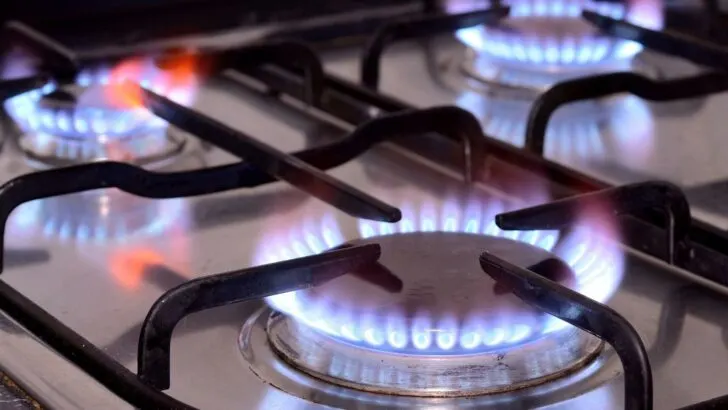
When attempting to calculate your general propane usage, remember to include all of your propane-fueled appliances.
For further information on propane use, refer to our posts “How Much Propane Does an RV Furnace Use?“ and “How Much Propane Does an RV Fridge Use?”
We also direct you to this “Propane Burn Time Calculator” which may be helpful in estimating how long your RV propane tank will last. The calculator allows you to enter the BTU rating of each propane appliance and the size of your tank to obtain the calculations.
Just remember to consider all of the variables as you estimate your propane needs.
If you’re wondering how much propane is left in your tank and you don’t have a gauge, check out our post and video on how to check the tank level without a gauge.
Can You Leave the Propane Tank On in an RV?
You can certainly leave the propane tank on/open when you’re parked and camping, using your propane appliances.
However, there are a couple of times when it’s best to turn your propane tank off.
The first is when your rig is stored. If you return home from a trip and don’t intend to use the RV for some time, you can turn your propane tank off since you won’t be using it. And you should definitely turn off your propane tank when your rig is in storage.
The reason for turning off your propane tanks when you’re not using the RV is that if you should develop a leak somewhere in the system, or if an appliance gets turned on accidentally, you wouldn’t know that there’s propane gas leaking. And this could create a serious explosion risk.
Another time you must turn off the propane is when the propane tank itself is being refilled. Although the person filling your tank for you will do that automatically.
All propane appliances should also be turned off during the filling of the propane tank so that no spark, flame, or other source of ignition is present. That’s also the reason that all propane appliances should also be turned off during the re-fueling of the RV itself.
The other time when it’s recommended to turn off your propane tank is when you’re driving.
We understand that people feel differently about this and there are many people who travel with their propane tanks on all the time.
However, in some states, there are laws regarding driving with your onboard propane tank on. Generally, these types of laws are related to tunnels.
For example, in Virginia, you need to stop to confirm that your tanks are off prior to driving your rig through a tunnel. In New York and New Jersey, you can’t drive through a tunnel or over some bridges with a propane tank open.
Can I Use a 100-Pound Propane Tank On My RV?
You absolutely can use a 100-pound propane tank on your RV. In fact, it’s done all the time.
Depending on the RV, of course, you could carry a 100-pound tank or a couple of 50-pound propane tanks connected by a pigtail.
However, you can also connect your RV to an external propane tank.
The following video shows how we connected to a large external propane tank when we were spending some time in a cold area in winter.
Why Are Propane Tanks Only Filled to 80%?
Like water, propane expands when it’s hot. However, its volume increases nearly 17 times more than water over the same temperature increase.
20% of the capacity of a propane container must be left empty to allow for this expansion.
This is why a propane tank can only be filled to 80%.
This is sometimes referred to as “the 80/20 fill rule” and it applies to all types of propane tanks, regardless of tank size.
Important Final Note Regarding RV Propane Safety
Every RV that uses propane or carries any type of propane tank must have a working propane detector. This is absolutely essential from a safety perspective.
Most RV propane detectors last from 5-7 years before they require replacement. However, it’s a good idea to replace your propane detector on a strict schedule so that you don’t forget and find yourself in a situation where it’s been 10 years since you’ve tended to yours.
Some propane detectors will beep in a regular pattern when they’re coming near the end of their effective lifetime. Never ignore this warning. It can be tempting to just disable the detector in an attempt to stop the beeping. But if you must do this to get through a night’s sleep, be sure to replace it at the soonest possible opportunity.
If your RV has a propane detector that’s hard-wired into the RV’s 12-volt electrical system, they’re very easy to replace on your own. We encourage you to check the date on yours today, and if it’s time to replace it, don’t wait.
Check your old propane detector for a similar replacement. It may look something like these:
- Double-Duty Alarm Detects Both Gas Leaks And Co Gas Simultaneously
- Reliable 12V Power Means No Missing Or Dead Batteries To Replace. Operating Temperature: minus 40° F To plus 158° F
- Includes mounting bracket
- Power Supply and Current Draw: 12 vDC 75mA @ 12 vDC
Another excellent piece of safety equipment to have onboard the RV is a combustible gas detector or “gas sniffer”. These are very helpful in quickly detecting gas leaks:
- 1.High Senstivity Quick Respon: Highly sensitive (adjustable) with a quick reaction time, you will be able to detect gas leaks within 10 seconds and...
- 2.Small Detector Super Sensor:A 14-inch flexible probe allows location and detection of leaks in hard-to-reach and confined spacesSix red LED's...
Remember – ignoring your propane detector can be an explosive mistake! Here’s a video showing how easy it can be to replace an RV propane detector:
Geek Out with Us Every Week
Join our newsletter to learn about all things RV-related. Every week we offer free tips, tricks, product reviews, and more to our online community of RVers. So, whether this is your first time on the road or you’re a seasoned expert, we’d love for you to geek out with us!




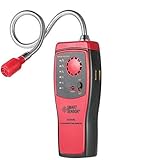
Gordon Hillesland
Friday 27th of October 2023
I have a Thor Gemini with a permanently installed propane tank. Fifty percent of the people who have attempted to put propane into the tank did not know the bleeder valve has to be opened to put gas in the tank. It is important that the vehicle owner knows how to fill the tank so the owner can instruct the employee. One man thought the only reason the valve had to be opened was to tell when the tank was full. He did not know the valve was opened to let the air out.
Billybob
Monday 23rd of October 2023
I started laughing before I finished your first sentence. Having grown up in the south, but living the last 35 years in New England, I completely agree that not mentioning that word that starts with a W, is completely appropriate. Especially this time of year as we enjoy the beautiful fall and fresh memories of warm summer days. My wife and I are on the last week of a month long trip in our Winnebago Vista29V, having camped in 5 national parks along the Shenandoah and Blue Ridge parkways and Mammoth Cave NP. One more stop at New River Gorge NP and then it’s back home for the w….., you know what I mean.
Thanks for all you do !
Billybob
TheRVgeeks
Tuesday 24th of October 2023
🤣😂 The "W" word is definitely a curse word as far as we're concerned, @Billybob!
KEVIN GOLDING
Monday 23rd of October 2023
Great article that explains many of the questions I've had for a long time. Thanks!!
TheRVgeeks
Tuesday 24th of October 2023
Great to hear, Kevin. Glad you enjoyed this.
Shannon
Thursday 8th of June 2023
Help!! I have a 1998 Holiday Rambler Endeavor, diesel pusher. Filled the propane, but I now I am NOT GETTING ANY PROPANE TO KITCHEN STOVE.
NO SMELL, NOTHING..yes, I turned the knob to lite, used the striker and held a lighter on with flame just to make sure... but NO PROPANE flowing!!!
Help...I'm stuck out in Jacksonville, FL...needing to get Home to Oregon.. Thank you, Shannon
TheRVgeeks
Thursday 8th of June 2023
Hi Shannon. Sorry for your trouble. This isn't an uncommon thing after having your propane tank filled... turning the tank back on too suddenly can trigger either the tank or the propane regulator to shut down, because the sudden surge of propane gas simulates the same situation as a sudden leak (from a burst hose/pipe). So the safety systems kick in and shut off the flow.
The best bet is to turn the propane off at the tank itself, then turn on a propane appliance like a stove burner to allow any pressure out. Turn the burner back off and wait a couple of minutes to allow any pressure between the tank and your onboard regulator to bleed off. Once you've waited, SLOWLY turn the valve at the tank back on, allowing the propane to flow into the system gradually. Once you've turned the tank back on, go back to the stove and turn a burner on... you should hear the "hissing" of gas flowing, but it probably won't light right away since the propane got bled out of the system. Carefully continue trying to light it until it lights and stays lit and you should be good.
Let us know if this fixes it for you.
leroy white
Monday 2nd of January 2023
If a RV trailer has two tanks connected together, should both valves be open to supply the water heater and furnace or should one valve be closed?
TheRVgeeks
Tuesday 3rd of January 2023
Hi Leroy... it depends on what type of system your trailer has on it. There's three ways your trailer could be set up:
With a single-tank regulator that needs to be manually removed from one propane tank and screwed into the other... most likely the situation if your trailer came from the factory with only one tank but you, or a previous owner, added a second tank without updating the regulator. In this case, of course, the second tank would have to be left closed until you've attached the regulator, otherwise it will be empty, too! ???? With a dual-tank regulator that has pigtails that connect to both tanks and has a switch built into it that enables you to select which tank is currently supplying propane. When one tank empties, you have to manually switch over to the second tank. Instead of relying on the switch in the regulator to keep the second tank closed, we recommend leaving the second tank's valve closed as an extra precaution against leaking. Since you have to manually switch between tanks when the first one runs out, you can close the valve on the empty tank, open the valve on the second tank, and switch the regulator switch over. With an automatic changeover dual-tank regulator. Similar to #2, except it automatically switches from the empty tank to the full one. While this is convenient so you don't have to go out in the cold/wet/dark when tank #1 runs out... you also won't KNOW that it happened and could end up running through the contents of BOTH tanks... which means you could run out of ALL propane (if your luck is like ours, that will happen late at night on a Friday of a holiday weekend while you're parked out in the boonies). So, you either need to be very diligent about checking levels of your tanks so you know when one is empty and it's switched over to the second (there should be a visual indication on the regulator/switch)... or you need to install some mechanism for remotely knowing the level of both tanks... OR you can just leave the second tank valve turned off. When you notice that tank #1 is empty, manually turn tank #2 on and you can refill tank #1.Hope that all makes sense!